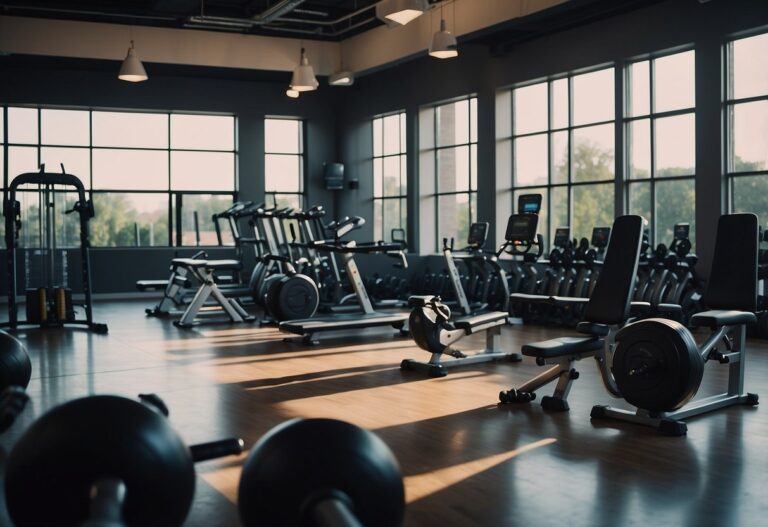Spending two hours in the gym each day can feel like a big commitment. Many gym-goers often wonder if this amount of time is truly necessary or even healthy.
The answer depends on your fitness goals and personal circumstances. For some, especially beginners, two hours can be excessive.

For others, such as athletes or those training for specific competitions, spending two hours might be beneficial. These long sessions can help build endurance, improve performance, and tackle different workouts. Yet, it’s essential to balance this with adequate rest and recovery to avoid overtraining, which can lead to injuries and burnout.
If your aim is general fitness or weight loss, shorter, more intense workouts can be just as effective. High-intensity interval training (HIIT) sessions can provide great results in less time. Plus, spreading your exercise throughout the week with activities like yoga or walking can contribute to a balanced routine.
You don’t need to spend hours at the gym to stay fit and healthy.
The Science Behind Workout Duration
Understanding how long you should spend exercising can be tricky. A key factor is your fitness goals. Are you aiming for weight loss, muscle gain, or simply overall health improvement? Different goals may require different amounts of time in the gym.
Studies show that effective aerobic exercise varies in duration.
Moderate-intensity aerobic exercise might involve activities like jogging or cycling. Experts suggest 150 to 300 minutes per week for significant health benefits. This is about 30 to 60 minutes per day, five times a week.
For more intense workouts, vigorous-intensity aerobic exercise is also essential. Activities like running or high-intensity interval training (HIIT) fall into this category. The recommended duration is about 75 to 150 minutes per week, equating to roughly 15 to 30 minutes per day.
Longer workouts have physiological impacts such as increased endurance and cardiovascular health. However, spending over 2 hours a day in the gym might lead to diminishing returns. Your muscles need time to recover, and over-exercise can cause fatigue and injuries.
The American Medical Association’s findings on exercise and longevity suggest that doing more than required often does not equate to better results.
Personal experience and individual differences also play a role. If you feel energised and not overly tired after 2 hours, it might work for you. However, always listen to your body and adjust your workout duration accordingly to find the optimal balance.
Benefits of a 2-Hour Gym Session

A two-hour gym session can provide you with a range of benefits. These benefits include comprehensive training that covers multiple muscle groups, enhanced skill development through focused practice, and improved mental health by allowing more time for stress relief and mental well-being.
Comprehensive Training
Spending two hours in the gym allows you to target different muscle groups in a single session. This extended time helps you incorporate a balanced mix of strength training, cardiovascular exercise, and flexibility workouts.
You can start with weight lifting to build muscle strength and then switch to running on the treadmill or cycling for cardiovascular fitness. Finally, you can round off your session with stretching or yoga to enhance flexibility.
This holistic approach ensures that you address all aspects of your fitness goals in one go, making your workout routine more efficient and effective.

Skill Development
A longer gym session gives you the opportunity to focus on perfecting your techniques and forms. Whether you’re aiming to improve your lifting technique, refine your skills in a particular sport, or work on your balance and coordination, more time allows for better attention to detail.
For example, if you’re learning a new yoga pose or trying to improve your squat form, having extra time means you can practice without feeling rushed. This can lead to better performance and reduce the risk of injury. It’s also a great chance to experiment with different exercises and discover what works best for achieving your personal fitness goals.
Mental Health
Exercise is well-known for its mental health benefits, and spending two hours at the gym can significantly enhance your mental well-being. Longer workouts provide a greater opportunity for stress relief and mental clarity.
During a two-hour session, you have the time to really get into the zone. This can act like a form of meditation, helping you to clear your mind and focus solely on the physical activity. Regular, longer workouts can improve your mood and lower anxiety levels, making you feel more centered and relaxed.
Engaging in a variety of exercises also prevents boredom and keeps your mind stimulated, which is key for maintaining a consistent workout routine.
Potential Drawbacks of Long Gym Sessions
Spending extended hours at the gym can lead to significant issues like risk of injury, poor time management, and inefficient workouts. It’s essential to balance exercise with rest and other daily activities.
Overtraining
Extensive gym sessions can put you at risk of overtraining. When you push your muscles, joints, and ligaments too hard without proper rest, you may experience physical stress and fatigue. This can increase the risk of injury such as sprains and strains. Exercise addiction is another concern, where you might feel compelled to work out excessively.
Over time, this can lead to serious conditions like tendonitis or stress fractures. It’s crucial to listen to your body and ensure you are allowing adequate recovery time.
Time Management
Spending two hours at the gym can be a challenge to manage, especially if you have a busy lifestyle. For professionals and students, finding such a large block of time daily can affect your productivity and other daily activities.

You may end up struggling to balance workouts with work, studies, and personal responsibilities. Shorter, more focused workouts can often be just as effective and easier to fit into a packed schedule, helping you stay on top of your tasks without sacrificing fitness.
Efficiency
Long gym sessions are not always the most efficient use of your time. You might find yourself wasting time with ineffective exercises or taking long rest periods between sets.
Focused workouts aim to maximise efficiency, allowing you to achieve better results in a shorter duration. By concentrating on high-intensity, compound movements, and minimising downtime, you can make your gym sessions more productive. This approach not only saves time but also enhances exercise intensity and effectiveness.
Remember, it’s about quality, not quantity. Prioritising efficient workouts can yield better fitness outcomes without requiring hours at the gym.
Optimising Your Workout Time
To make the most of your gym sessions, you can incorporate strategies like high-intensity interval training (HIIT), supersets, circuits, and managing your rest periods effectively. These methods ensure you get a comprehensive workout without spending excessive time at the gym.
High-Intensity Interval Training (HIIT)
High-Intensity Interval Training, or HIIT, involves short bursts of intense exercise followed by brief rest periods. This method is efficient and effective in elevating your heart rate and burning calories quickly.
For example, you can alternate between 30 seconds of sprinting and 30 seconds of walking.
HIIT workouts are flexible. You can combine activities like running, cycling, and bodyweight exercises. The key is to push yourself during the high-intensity phases and allow your body to recover briefly during the rest periods. This balance boosts cardiovascular fitness and promotes fat loss.
Due to its demanding nature, it is important to listen to your body and ensure adequate rest and recovery between HIIT sessions. Incorporating this training into your routine can enhance your fitness level without spending hours in the gym.

Supersets and Circuits
Supersets and circuit training are excellent for maximising workout efficiency.
Supersets involve performing two exercises consecutively without resting in between. For example, you can pair a chest press with a row exercise. This method keeps your muscles engaged and reduces overall workout time.
Circuit training involves completing a series of exercises, one after another, with minimal rest. This approach targets different muscle groups and combines strength training with cardiovascular exercise. For instance, a circuit might include squats, push-ups, and jumping jacks.
Both methods increase workout intensity and save time. They help in building muscle, improving endurance, and burning calories. Trainers recommend these techniques for anyone looking to make their workouts more effective and efficient.
Rest Periods
Managing rest periods is crucial for maintaining workout intensity and preventing burnout.
Shortening rest times between sets can keep your heart rate elevated and increase calorie burn. For strength training, rest periods of 30-90 seconds are often effective, while HIIT might use even shorter durations.
It’s essential to tailor rest periods to your fitness level and workout goals. Adequate rest and recovery are important to avoid overtraining and injuries. Professional advice often highlights the importance of listening to your body and adjusting rest times accordingly.
Tailoring Workout Duration to Individual Goals

It’s important to match your workout duration with your fitness goals. This helps maximise results while reducing the risk of injury and fatigue. Different goals, like building strength, improving cardiovascular health, or enhancing flexibility, require different approaches.
Strength Training
For strength training, the ideal workout duration is typically between 45 minutes to an hour. Focusing on muscle growth, you need to include a mix of compound and isolation exercises.
Compound exercises like squats, deadlifts, and bench presses work multiple muscle groups and are efficient for building overall strength.
Add a few isolation exercises, such as bicep curls or tricep extensions, to target specific muscles. Keep rest periods between sets at around 1-2 minutes to allow for muscle recovery.
Maintaining this balance avoids overtraining and helps you achieve your muscle growth goals without spending excessive time in the gym.
Make sure to consult with trainers to personalise your workout routine. Varying your workouts and progressively increasing weights can keep you engaged and prevent plateaus.
Cardio and Endurance

When aiming for improved cardiovascular fitness, workout duration and frequency vary based on your fitness level and goals. Generally, 30 to 60 minutes of moderate to intense cardio sessions, three to five times a week, is effective. Activities like running, cycling, and swimming are excellent choices for endurance training.
These longer workout sessions help build stamina and boost heart health. It’s important to listen to your body to avoid overexertion.
Start with shorter sessions if you’re new to exercising and gradually increase the duration as your endurance improves.
Incorporate a mix of high-intensity interval training (HIIT) for variety. This not only keeps your routines exciting but can also enhance results by challenging your body in different ways.
Flexibility and Mobility
Integrating stretching and mobility work into your routine is essential for preventing injuries and improving overall movement. Spending about 10-15 minutes on flexibility exercises like stretching, yoga, or Pilates at the end of each session can be very beneficial.
Activities focused on flexibility and mobility support muscle recovery and reduce the risk of strains. Regularly practising these exercises can improve your range of motion and posture, making your other workouts more effective.
For people with physical limitations or those new to flexibility training, gentle movements and shorter sessions are a good start. Gradually increase the intensity and duration as you become more comfortable.
This helps in developing a sustainable routine that enhances your flexibility and mobility over time.
Practical Tips for Busy Individuals
Balancing a busy lifestyle with regular exercise can be challenging. Focusing on time-saving strategies, effective scheduling, and emphasising consistency can help you meet your fitness goals without spending hours in the gym.
Time-Saving Strategies
When you’re short on time, focused workouts can be incredibly efficient. High-Intensity Interval Training (HIIT) is a great option. By alternating periods of intense exercise with short rest, you can improve your fitness level in as little as 20-30 minutes.
Strength training doesn’t have to be time-consuming either. Compound exercises, like squats and bench presses, work multiple muscle groups at once, making your workout more efficient. Limiting the use of seated exercises can also save time by keeping you active and engaged.
Pairing exercises, such as doing upper body movements while resting the lower body, can reduce the total time needed for a workout. Gym hacks like setting up all your equipment beforehand or using supersets can help maximise your gym time.
Scheduling

Finding time to work out in a busy schedule might seem tough, but with the right approach, it’s manageable. Morning workouts can be a good start. Exercising in the morning helps in staying consistent and sets a positive tone for the day.
Planning your week can help you find those precious slots of free time. Even 45-minute sessions squeezed into lunch breaks or early mornings can make a difference. Increasing your activity by incorporating mini-workouts during idle times, like doing squats while watching TV, can also be productive.
Apps and reminders can keep you on track with your fitness goals. Setting a routine that fits your lifestyle, such as alternating between strength training and cardio, can ensure balanced and effective workouts.
Consistency Over Duration
Consistency is more important than extended workout durations, especially for long-term fitness.
Aiming for regular exercise, even if it’s brief, can build a sustainable habit. Doing a little every day can prevent the negative effects of inactivity.
Keep track of your fitness progress to stay motivated.
Seeing improvements, even small ones, can be encouraging and help you stay committed.
It’s often better to have short, effective workouts consistently rather than infrequent, longer sessions.
Incorporating variety can keep you engaged.
Switching up your routines, whether it’s through different exercises or varying the intensity, can prevent boredom and keep you motivated.
A long-term commitment to fitness doesn’t require marathon sessions; it’s about forming a habit that fits into your daily life.







